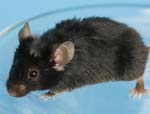Phenotypes associated with this allele
|
|
| Find Mice |
Using the International Mouse Strain Resource (IMSR)
Mouse lines carrying:
Aars1sti mutation
(1 available);
any
Aars1 mutation
(68 available)
|
|
|

Aars1sti/ Aars1sti
nervous system
|
N |
• No changes in microtubule levels are found in Purkinje cells
|
|
|
• loss of cells beginning at three weeks of age
• extensive cell loss by six weeks of age especially in rostral cerebellum
|
behavior/neurological
|
|
• mild tremors occur at 6 weeks of age and progress to ataxia
|
|
|
• as demonstrated by rotorod
|
integument
|
|
• patchy hair loss occurs over time
|
|
|
• fur has rough, unkempt, sticky appearance
• electron microscopy indicates short, broken, deformed hair fibers
|
|
|
• hair fibers break at follicular ostium and have cuff of compacted inner root sheath cells
|
|
|
• hyperplasia of outer root sheath
|
|
|
• hair fibers twisted within the follicle
|
|
|
| Find Mice |
Using the International Mouse Strain Resource (IMSR)
Mouse lines carrying:
Aars1sti mutation
(1 available);
any
Aars1 mutation
(68 available)
Aars1tm1Slac mutation
(0 available);
any
Aars1 mutation
(68 available)
|
|
|
homeostasis/metabolism
cardiovascular system
|
|
• ubiquitin puncta are present in about 2.4% of cardiomyocytes
• cardiomyocytes exhibit deposition of protein aggregates that disrupt myofibrillar structure and these protein aggregates occur in prefibrotic hearts
• large vacuoles and a reduction in fiber diameter are often seen in ubiquitin aggregate-containing cardiomyocytes
• mitochondria and sarcoplasmic reticulum are abnormal in cardiomyocytes
|
|
|
• abnormal mitochondria in cardiomyocytes
|
|
|
• myofiber disarray in the ventricular myocardium of hearts
|
|
|
• heart is smaller than in single homozygous Aarssti mice
|
|
|
• hearts exhibit a slight, but significant, reduction in the thickness of the left ventricular posterior wall
|
|
|
• extensive cardiac fibrosis is seen at 4 and 10 months of age
• interstitial and perivascular fibrosis in the left and right ventricular walls and in the interventricular septum
|
|
|
• in the left and right ventricular walls and in the interventricular septum
|
|
|
• less systolic thickening of the left ventricle, indicating myocardial dysfunction
|
|
|
• ventricular output, as measured by the ejection fraction and fractional shortening of the left ventricle, are reduced
|
|
|
• ejection fraction and fractional shortening of the left ventricle are reduced
• however, ventricular arrhythmias are not seen
|
|
|
• cardiomyocytes exhibit multilamellar bodies indicative of impaired lysosomal degradation
|
cellular
|
|
• abnormal mitochondria in cardiomyocytes
|
|
|
• in the left and right ventricular walls and in the interventricular septum
|
growth/size/body
|
|
• decreased body weight at P21 but not P14
|
integument
muscle
|
|
• ubiquitin puncta are present in about 2.4% of cardiomyocytes
• cardiomyocytes exhibit deposition of protein aggregates that disrupt myofibrillar structure and these protein aggregates occur in prefibrotic hearts
• large vacuoles and a reduction in fiber diameter are often seen in ubiquitin aggregate-containing cardiomyocytes
• mitochondria and sarcoplasmic reticulum are abnormal in cardiomyocytes
|
|
|
• abnormal mitochondria in cardiomyocytes
|
|
|
• myofiber disarray in the ventricular myocardium of hearts
|
|
|
• ejection fraction and fractional shortening of the left ventricle are reduced
• however, ventricular arrhythmias are not seen
|
|
|
• disruption of the sarcoplasmic reticulum in cardiomyocytes
|
nervous system
|
|
| Find Mice |
Using the International Mouse Strain Resource (IMSR)
Mouse lines carrying:
Aars1sti mutation
(1 available);
any
Aars1 mutation
(68 available)
Aars1tm1.1Slac mutation
(0 available);
any
Aars1 mutation
(68 available)
|
|
|
cardiovascular system
|
|
• ubiquitin and p62-positive puncta are seen in cardiomyocytes
|
|
|
• widespread myocardial fibrosis at 4 months of age
|
growth/size/body
integument
muscle
|
|
• ubiquitin and p62-positive puncta are seen in cardiomyocytes
|
|
|
| Find Mice |
Using the International Mouse Strain Resource (IMSR)
Mouse lines carrying:
Aars1sti mutation
(1 available);
any
Aars1 mutation
(68 available)
Ankrd16tm1.1Slac mutation
(0 available);
any
Ankrd16 mutation
(25 available)
|
|
|
mortality/aging
|
|
• fewer than expected mice are present at E8.5 and E9.5 with no mice at E10.5
|
|
|
| Find Mice |
Using the International Mouse Strain Resource (IMSR)
Mouse lines carrying:
Aars1sti mutation
(1 available);
any
Aars1 mutation
(68 available)
Ankrd16rs251476964-A mutation
(0 available);
any
Ankrd16 mutation
(25 available)
Ankrd16rs251476964-G mutation
(0 available);
any
Ankrd16 mutation
(25 available)
|
|
|
nervous system
|
N |
• Background Sensitivity: unlike mice on a congenic C57BL/6J background, mice on a mixed background including CASA/RkJ do not exhibit ataxia or Purkinje cell degeneration
|
|
|
• in some neurons in the rostral cerebellum
|
behavior/neurological
|
N |
• Background Sensitivity: unlike mice on a congenic C57BL/6J background, mice on a mixed background including CASA/RkJ do not exhibit ataxia or Purkinje cell degeneration
|
|
|
| Find Mice |
Using the International Mouse Strain Resource (IMSR)
Mouse lines carrying:
Aars1sti mutation
(1 available);
any
Aars1 mutation
(68 available)
Ankrd16rs251476964-G mutation
(0 available);
any
Ankrd16 mutation
(25 available)
|
|
|
behavior/neurological
|
N |
• Background Sensitivity: unlike mice on a congenic C57BL/6J background, mice on a mixed background including CAST/Ei do not exhibit ataxia or Purkinje cell degeneration
|
nervous system
|
N |
• Background Sensitivity: unlike mice on a congenic C57BL/6J background, mice on a mixed background including CAST/Ei do not exhibit ataxia or Purkinje cell degeneration
|
|
|
| Find Mice |
Using the International Mouse Strain Resource (IMSR)
Mouse lines carrying:
Aars1sti mutation
(1 available);
any
Aars1 mutation
(68 available)
Ankrd16rs251476964-A mutation
(0 available);
any
Ankrd16 mutation
(25 available)
|
|
|
behavior/neurological
nervous system



 Analysis Tools
Analysis Tools